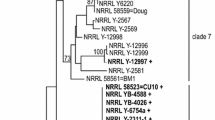Abstract
Penicillium species were analyzed with molecular markers and for pectinase and cellulase production. RAPD and PCR-RFLP analysis indicated high polymorphism among at least 5 of 10 Penicillium species. Five species were chosen for pectinase and cellulase production in liquid medium and four of which appeared similar based on molecular analyses. P. brevicompactum and P. griseoroseum gave the highest pectinase production and were highly divergent by molecular techniques.
Similar content being viewed by others
References
Alaña A, Gabilondo A, Hernando F, Moragues MD, Dominguez JB, Llama MJ, Serra JL (1989) Pectin lyase production by a Penicillium italicum strain. Appl. Environ. Microbiol. 55: 1612-1616.
Albersheim P (1966) Pectin lyase from fungi. In: Neufeld EF, Ginsburg V, eds. Methods in Enzymology, Vol. 8. New York: Academic Press, pp. 628-631.
Baracat MC, Valentin C, Muchovej JJ, Silva DO (1989) Selection of pectinolytic fungi for degumming of natural fibers. Biotechnol. Lett. 11: 899-902.
Boysen M, Skouboe P, Frisvad J, Rossen L (1996) Reclassification of the Penicillium roqueforti group into three species on the basis of molecular genetic and biochemical profiles. Microbiology 142: 541-549.
Brimer L, Cicalini AR, Federici F, Petruccioli M (1994) Production of β-glycosidases (linamarase and amygdalase) and pectolytic enzymes by Penicillium spp. World J. Microbiol. Biotechnol. 10: 203-206.
Brumano MHN, Coelho JLC, Araújo EF, Silva DO (1993) Pectin lyase activity of Penicillium griseoroseum related to degumming of ramie. Rev. Microbiol. 24: 175-178.
Cruz CD (2001) Programa GENES-versão Windows. Viçosa: Editora UFV.
Cruz CD, Regazzi AJ (1994) Modelos biométricos aplicados ao melhoramento genético. Viçosa: Imprensa Universitária.
Dupont J, Magnin S, Marti A, Brousse M (1999) Molecular tools for identification of Penicillium starter cultures used in the food industry. Int. J. Food Microbiol. 49: 109-118.
Durand N, Reymond P, Fèvre M (1993) Randomly amplified polymorphic DNAs assess recombination following an induced parasexual cycle in Penicillium roqueforti. Curr. Genet. 24: 417-420.
Kashyap DR, Vohra PK, Chopra S, Tewari R (2001) Applications of pectinases in the commercial sector: a review. Biores. Technol. 77: 215-227.
Lobuglio KF, Taylor JW (1995) Phylogeny and PCR identification of the human pathogenic fungus Penicillium marneffei. J. Clin. Microbiol. 33: 85-89.
Lobuglio KF, Pitt JI, Taylor JW(1993) Phylogenetic analysis of two ribosomal DNA regions indicates multiple independent losses of a sexual Talaromyces state among asexual Penicillium species in subgenus Biverticillium. Mycologia 85: 592-604.
Nei M, Li W (1979) Mathematical model for studying genetic variation in terms of restriction endonucleases. Proc. Natl. Acad. Sci. USA 76: 5269-5273.
Paterson RRM, Bridge PD, Crosswaite MJ, Hawksworth DL (1989) A reappraisal of the Terverticillate Penicillia using biochemical, physiological and morphological features III. An evaluation of pectinase and amylase isoenzymes for species characterization. J. Gen. Microbiol. 135: 2979-2991.
Pitt JI (1995) Phylogeny in the genus Penicillium: a morphologist's perspective. Can. J. Bot. 73: S768-S777.
Pitt JI, Hocking AD (1999) Fungi and Food Spoilage, 2nd edn. Maryland: Aspen.
Sequerra J, Marmeisse R, Valla G, Normand P, Capellano A, Moiroud A (1997) Taxonomic position and intraspecific variability of the nodule forming Penicillium nodositatum inferred from RFLP analysis of the ribossomal intergenic spacer and random amplified polymorphic DNA. Mycol. Res. 101: 465-472.
Sneath PHA, Sokal RR (1973) Numerical Taxonomy. San Francisco: Freeman.
Speacht CA, DiRusso CC, Novotny CP, Ullrich RC (1982) A method for extracting high-molecular-weight deoxyribonucleic acid from fungi. Anal. Biochem. 119: 158-163.
Statsoft, Inc. (1995) STATISTICA for Windows (computer program manual). Tulso, Oklahoma.
White TJ, Bruns T, Lee S, Taylor J (1990) Amplification and direct sequencing of fungal ribossomal RNA genes for phylogenetics. In: Innis MA, Gelfand DH, Sninsky JJ, White TJ, eds. PCR Protocols: A Guide to Methods and Applications. San Diego: Academic Press, pp. 315-322.
Williams JG, Kubelik AR, Livak KJ, Rafalski JA, Tingey SV (1990) DNA polymorphisms amplified by arbitrary primers are useful as genetic markers. Nucl. Acid Res. 18: 6531-6535.
Author information
Authors and Affiliations
Rights and permissions
About this article
Cite this article
Pereira, J.F., Vieira de Queiroz, M., Aparecida Gomes, E. et al. Molecular characterization and evaluation of pectinase and cellulase production of Penicillium spp.. Biotechnology Letters 24, 831–838 (2002). https://doi.org/10.1023/A:1015502721909
Issue Date:
DOI: https://doi.org/10.1023/A:1015502721909




